
The AK-12 has improved ergonomics and modularity over the AKM, AK-74 and AK-74M.
- Introduced in 2012, the AK-12 is the latest AK-47 variant, though even it has evolved to today’s version.
- Improvements include better ergonomics, less recoil, faster cooling and can be loaded one-handed.
- The latest AK-12 uses an AR-style telescoping stock.
- Thanks to the import ban, the author made an AK-12 clone based on an I.O., Inc. prototype rifle.
- The author’s replica used parts from FAB Defense, Brownells, Geissele Automatics, Legion USA and K-Var Corp.
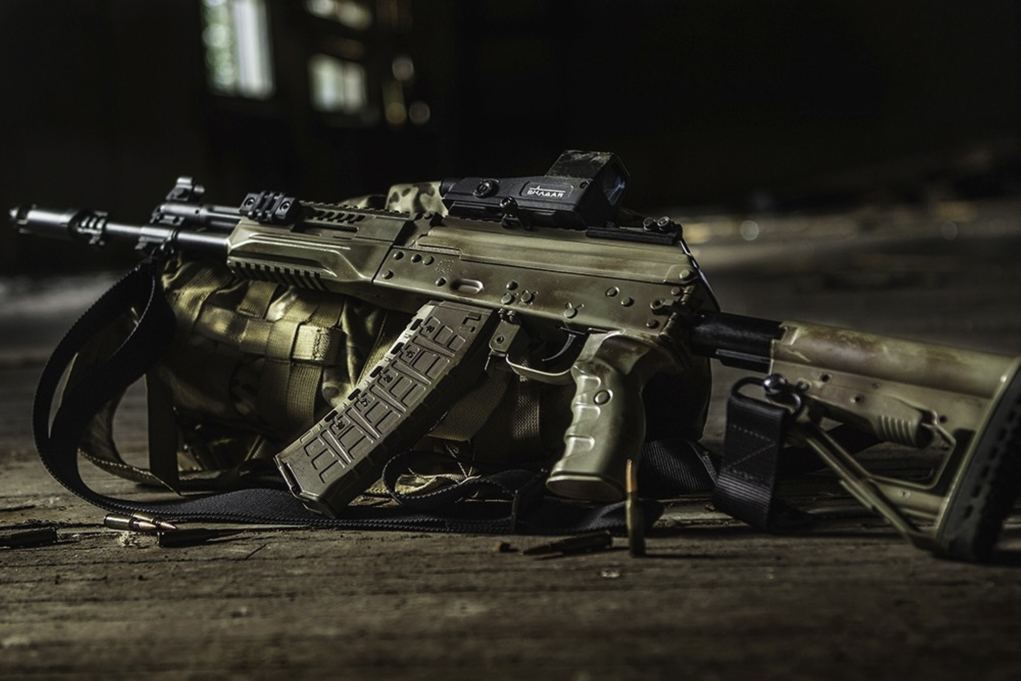
As the AK evolution continues, it will reach critical mass when drastic gun re-design must occur to guide further development of the AK. The AK-12 Avtomat is the newest version of the Kalashnikov-designed rifle, created in 2012. It is a promising product developed by the Kalashnikov Concern at its Izhevsk Plant.
The main feature of the AK-12 is improved ergonomics and modularity in comparison with its predecessors, the AKM, AK-74 and AK-74M. According to the gun designers, they improved the service life, reliability and accuracy of the gun.
The AK-12 demonstrates excellent characteristics during initial testing. It has less recoil, better cooling, is lighter and shorter, and can be reloaded with one hand. That’s why in 2015 the AK-12 Kalashnikov Avtomat was adopted and will be used as the main personal weapon for the Russian individual soldier equipment complex Ratnik.
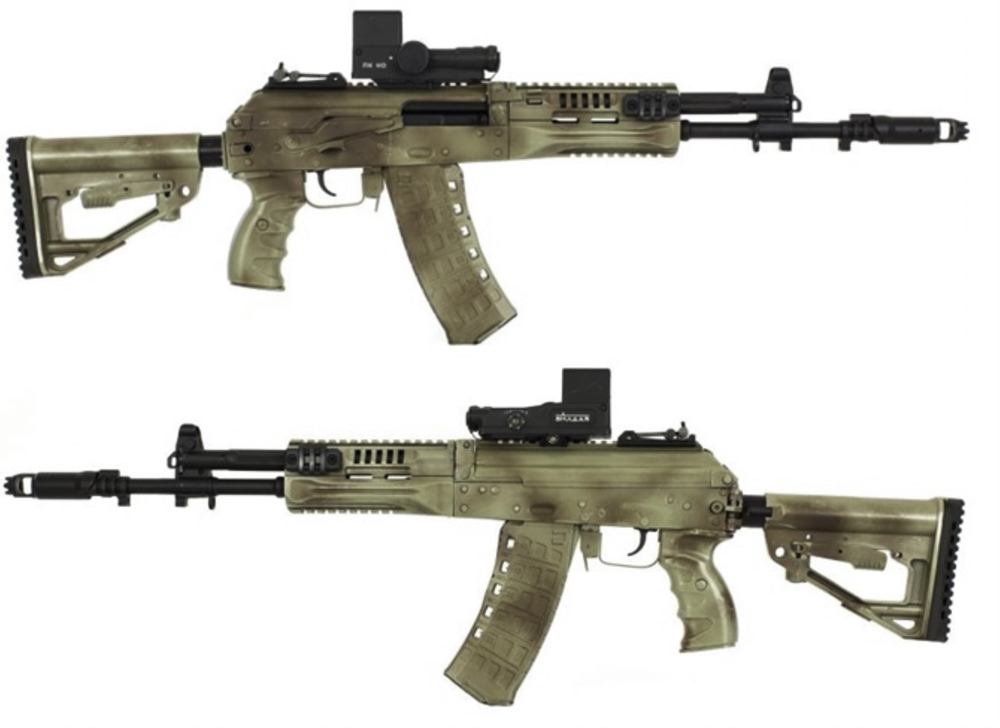
Is it the same AK-12 they demonstrated in 2012? Not really. In fact, not at all.
The development of the new machine started in June 2011 under the leadership of the well-known chief designer of Izhmash, Vladimir Viktorovich Zlobin. It was entirely an Izhmash initiative.
The new AK was based on the work and experience accumulated over the last 10 years. In 2011, the prototype was completed and testing of the fifth-generation Avtomat with the name AK-12 began. The AK-12 is designed to replace the previous versions of the AK-103, AK-74M, AK-74 and early AKM, AKMS and all other AKs still in service.
For the first time, the AK-12 was shown to the public in January 2012, hence its index “12.” The main goals in the development of the AK-12 were to:
- Increase the universality of the gun.
- Improve the ergonomic characteristics.
- Preserve and possibly improve the gun’s main performance characteristics (accuracy of fire, survivability, reliability in different modes).
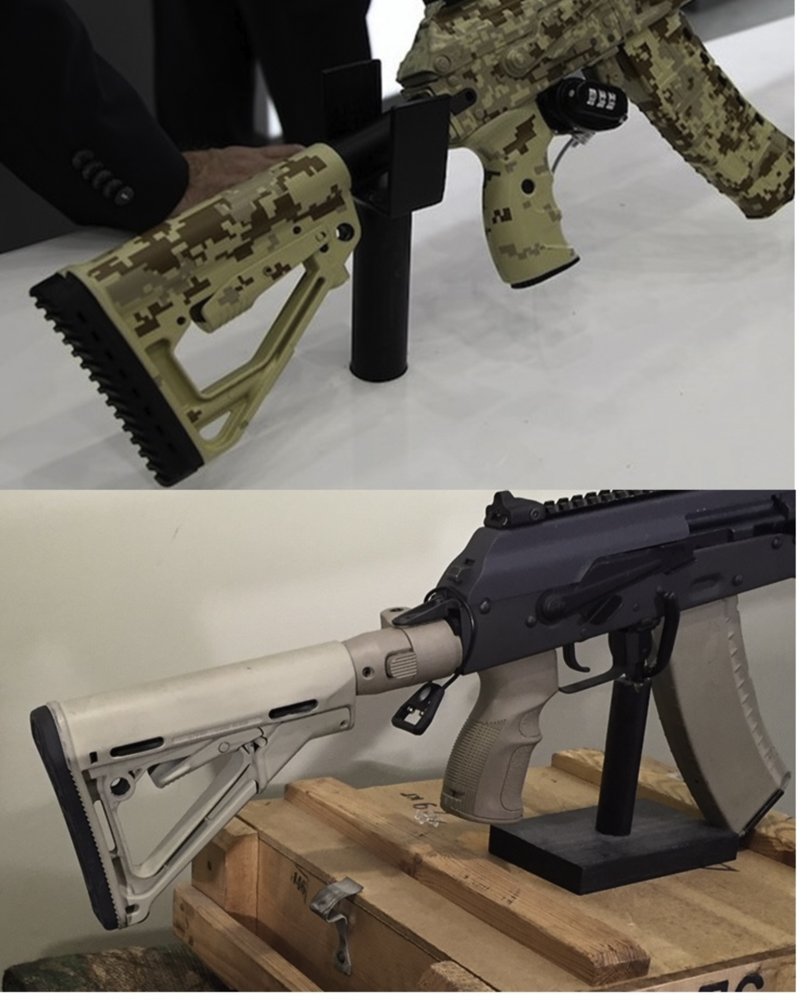
The Russian government was not eager to provide any support to development of the new Avtomat, citing the success of old AKs. So, they didn’t. During the period of 2013 and 2014, the AK-12 encountered some opposition from the Russian military under the pretext of many shortcomings, so state financing of the trials was denied. Nevertheless, on February 21, 2015, the Ministry of Defense evaluated the characteristics of the newly upgraded AK-12.
As a result, it was adopted as the main weapon for the Ratnik individual equipment complex, alongside its more expensive and heavier competitor, the A-545. It also received a preferential role over the balanced automatics Avtomat.
In 2015, after preliminary tests, the fifth-generation Avtomat, already adopted for service, got a number of upgrades. The highlighted deficiencies were not critical to the design and would be corrected within a year. After the new Avtomat was tested again and passed the government tests with flying colors, its arrival in the Russian armed forces was slotted for 2016.
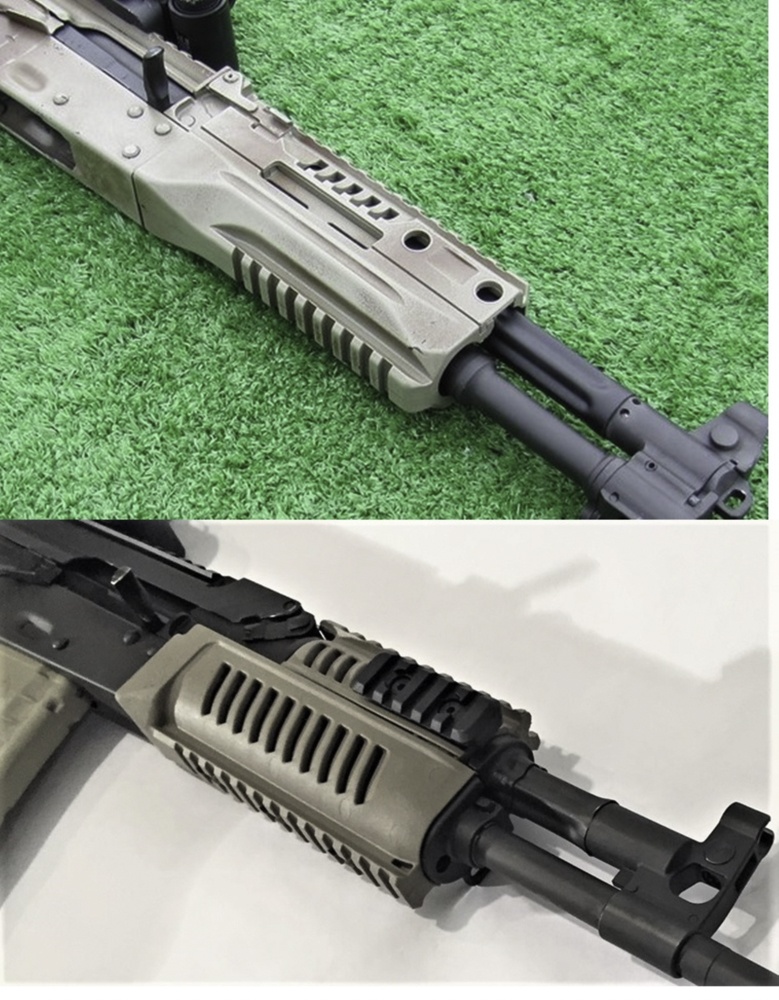
The AK-12 has the following tactical and technical characteristics:
- Caliber: 5.45x39mm
- Length: 730/940 mm (29.75/37 inches) with stock folded/unfolded
- Weight (without cartridges): 3.2 kg (7.1 lbs.)
- Barrel length: 415mm (16.3 inches)
- Bullet velocity: 900m/s (2,952 fps)
- Rate of fire: 650 rds/min.
- Max. aiming range: 1,000 m.
- Max. effective range: 600 m.
- Magazine capacity: 95 rounds for drum magazine, 30 or 60 rounds for box-type mags
- Firing modes: automatic, fixed 3-shot burst and single shot
All of this is in line with its previous model. You do not have to be an experienced firearms designer or famous gunsmith to see that the new AK-12, though it is a clearly a new weapon type, is still an AK. In fact, it appears to be a compromise between the original AK-12 and the modernization kit.
It appears to have the standard AK-74 stamped receiver, which encompasses the standard trigger and bolt groups. It takes a slight departure from the norm in a copy of the Krebs enhanced safety lever, which is not what the highly publicized original AK-12 had. There is no button mag release. Instead, the regular AK latch is used.
The AR-style telescopic stock is installed instead of the multi-functional stock of the original gun. The stock-folding mechanism is identical to the AK-74. My very own AKS had the same one 30 years ago. The pistol grip is more ergonomic, and similar to one from Israel’s FAB Defense or CAA.
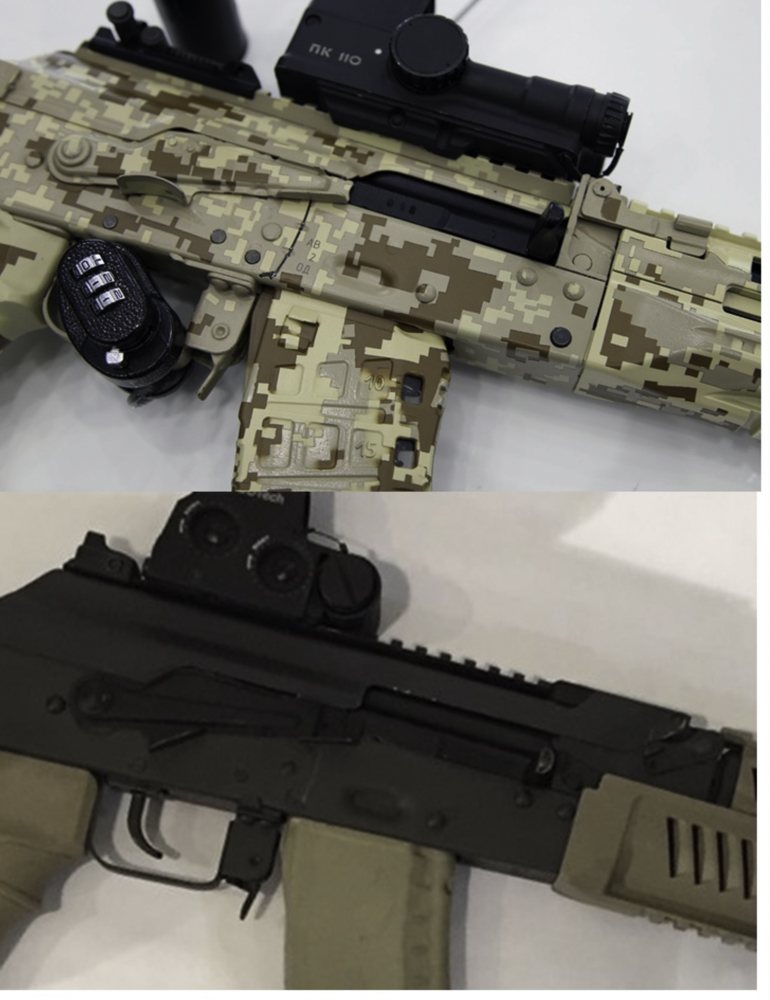
The top cover is hinged, using completely new mounting and retention mechanisms, but similar to the modernization kit nonetheless. The rear sight block is modified and no longer supports the rear sight. Instead, it is now used for the top cover hinge and to retain the upper handguard more firmly.
The rear sight block is now removable and can be installed anywhere along the Picatinny rail that runs the entire length of the top cover and aligns perfectly with the section atop the upper handguard. The upper handguard has two mounting spots for small Picatinny rail sections, one on each side. The matching lower handguard has the rail at the bottom. The length of the handguards is about the same of those on the AK-74 with exception of the upper.
The differences begin forward of the handguards. Although the gas tube appears to have the same length and similar design, minus the upper handguard brackets, the gas block is a different story. It is a gas/front sight block combination of new design. It is higher than the standard AK and has the gas chamber going all the way forward, where it is topped with a gas regulator. The accessory lug is at the bottom of the combination block for mounting a grenade launcher.
The muzzle of the upgraded AK-12 is tipped with a threaded block that sports a detent pin and bayonet lug. The gun uses two different muzzle devices. One is a modified version of the AK-74 brake and the other is similar to that of the Polish Tantal rifle.
It is slimmer than the original AK-74 brake and much longer. According to AK-12 designers, this was done for use with foreign rifle grenades. I like the idea. I also think that the Polish Tantal muzzle brake is very effective.
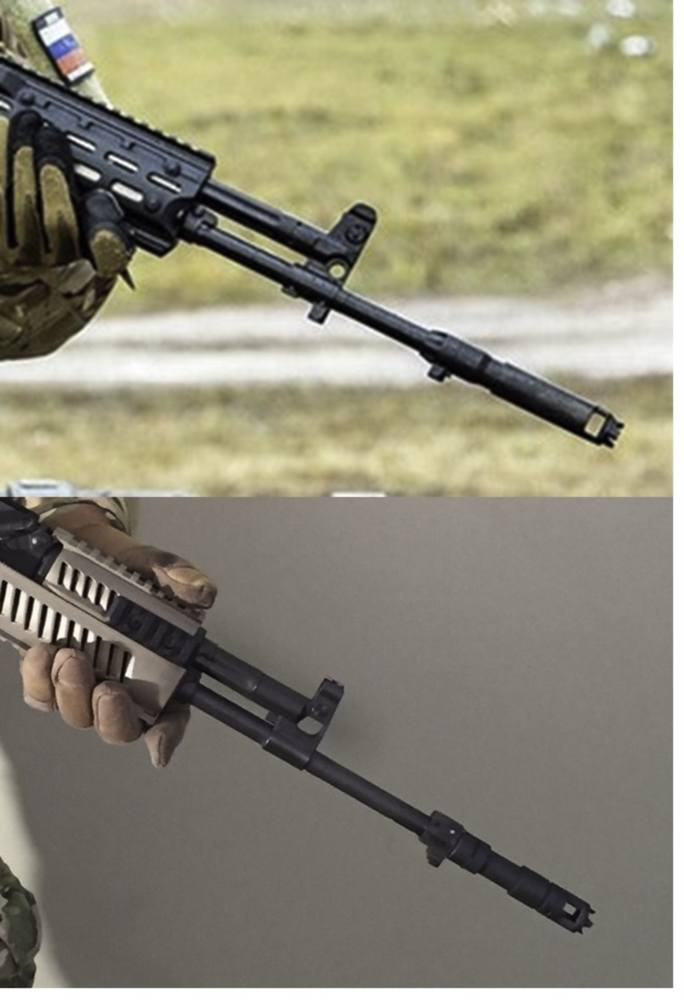
That’s it. That’s what the AK evolved into. I don’t know why the Russians didn’t go with the original AK-12 design and instead settled for this one. Most likely, it was a question of funds needed for retooling the plant and more complicated (read more expensive) manufacturing process. However, I rather like it.
It is intimately familiar to AK fans, it has all the features that a modern gun should have, it’s lightweight and looks like a comfortable rifle. In addition, if you believe the designers, it is a better shooting AK than its predecessors. I would not mind owning one.
However, since there is no possibility of the AK-12 in its Saiga livery ever making it here, I have to build one.
Building Your Own AK-12
By now you know I had to see if the latest solutions employed by the Kalashnikov Concern’s gun designers could be replicated. I had to build one of my own to find out if it handles or shoots as claimed.
I once more embarked on the exciting journey of replicating something I cannot have otherwise.
My biggest challenge initially was to find a donor gun in the proper caliber. There were two ways to do this. One was to find a complete gun with gas/front sight combination in 5.45x39mm. The other was to get a standard AK-74 and press off the gas block and front sight and replace them with the combo. I spent a week looking around and considering my options.
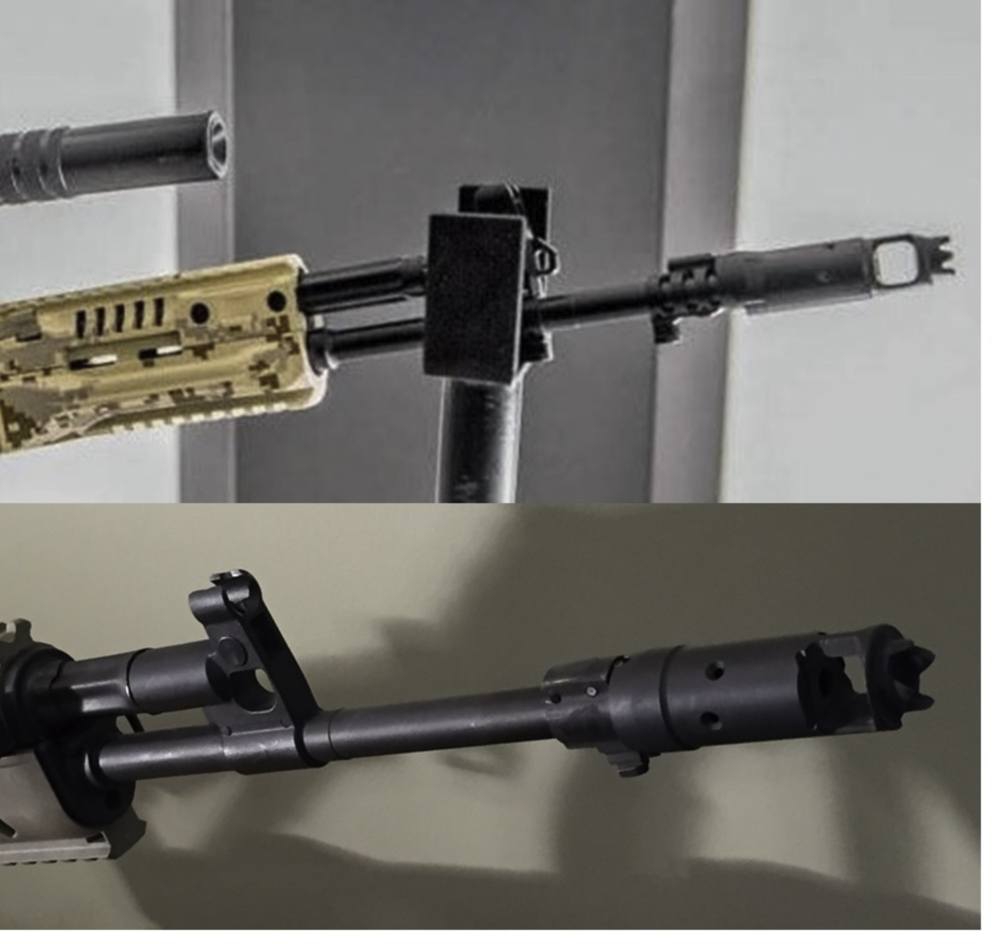
The solution was an I.O., Inc., prototype rifle. The new rifle the company was working on was a combination of its M214 rifle and the AK-74. The new rifle had a combination block and threaded barrel. Exactly what I needed.
Having obtained a donor rifle, it was time to collect the rest of the components. By analyzing images of the new Russian AK-12, I came up with a list. Yet again, I tapped into FAB Defense, Brownells, Geissele Automatics, Legion USA and K-Var Corp. as sources for the needed components. Additionally, I anticipated some actual gunsmithing work would need to be done to finish this project.
As always, I started with the buttstock because it is the easiest thing to replace. By looking at the new AK-12 stock, I could not help but notice that it bears an uncanny resemblance to MagPul’s CTR model. Telescopic and folding features for the AK-12 were easier to copy. Out of consideration for weight, I went with the FAB Defense plastic joint M4-AK P folding tube and MagPul CTR stock, once more provided by Brownells.
Just like the earlier model AK-12 and the modernization kit, the new gun’s pistol grip is essentially a copy of CAA’s ergonomic grip, the G47. FAB Defense was gracious enough to provide its AG-47S grip for the project; it is similar in design and fits perfectly on the gun.
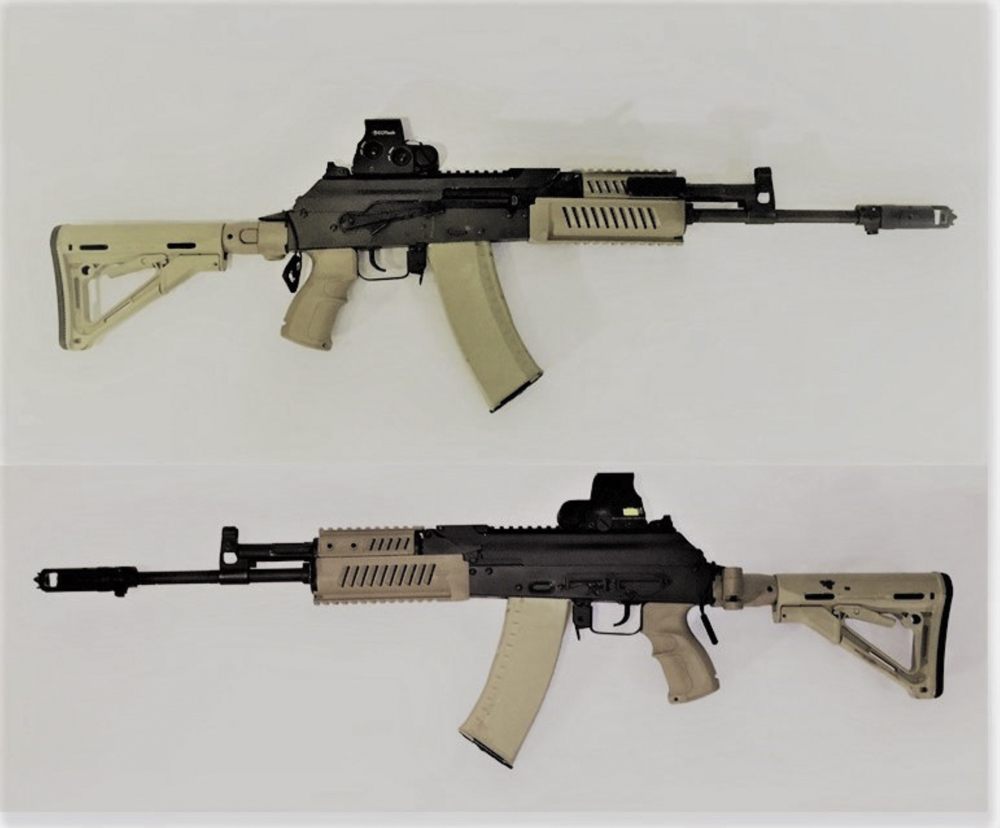
I had to ponder which handguards to use on my AK-12 clone this time. The new Russian AK has handguards that are matching in length and parallel, with rails at the top and bottom. The clue came from the way the side rail sections mount the handguards.
The AK-12’s Picatinny side rails mount to the upper handguard, instead of the more traditional way to the lower. FAB Defense makes its AKL-47/74 guards with the same mounting option. After taking a closer look at these handguards I thought they were very similar to the originals. I got the FAB Defense handguards and installed them on my gun using standard AK brackets and hardware. I chose the dark earth color for my accessories to most closely resemble the original.
The next step turning the I.O., Inc., gun into the newest Russian AK was the hinged top cover. As previously noted, I have considerable experience with these and used them on previous builds. My preferred railed top cover was the Parabellum AKARS.
Except this time I wanted something else. My search revealed the Russian Red Heat AK dust cover with rail from Legion USA. It installed into the rear side leaf hinge and dropped into place as if it was an original part. Once on the gun, I noticed that it matched the upper handguard rail height perfectly. My rifle was starting to look like the original AK-12. Nevertheless, there was still plenty to do.
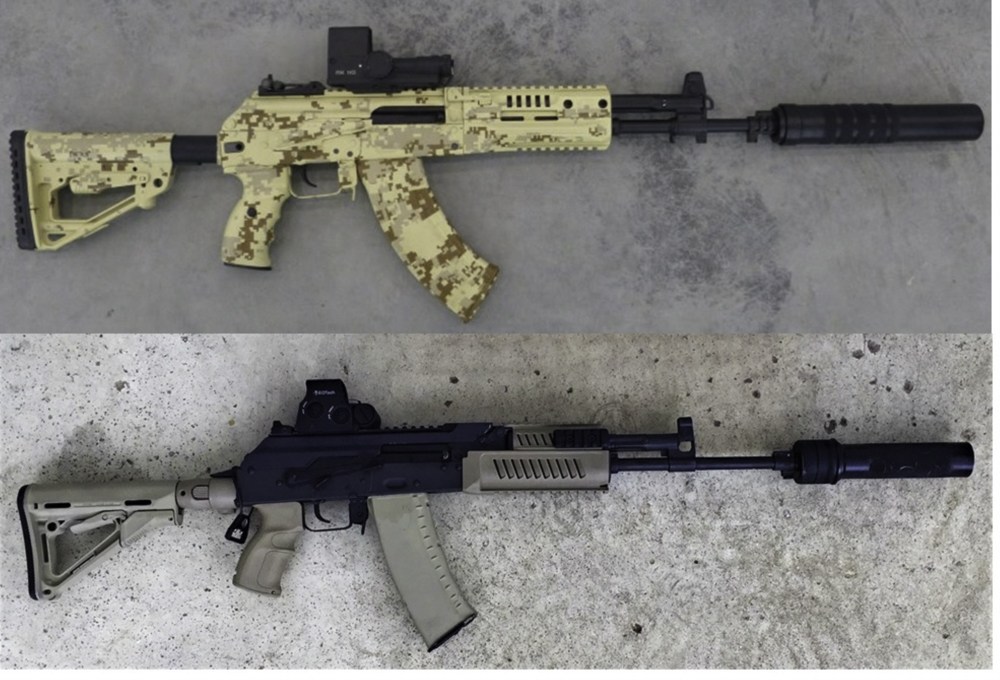
One more part that came from Legion USA was the Russian version of the Krebs Enhanced Safety lever. I thought I would stay as authentic as I could and used it on my clone along with the Geissele ALG AK High Energy Hammer Spring and the two-zone compression return spring.
I decided to try a different trigger group for the AK-12 this time. I opted for the FIME Group’s (affiliated with K-Var Corp. and Arsenal USA) FM-922US trigger group. It was a drop-in replacement and had the look of the regular AK trigger, but with definite performance improvement.
The main body of the gun was done with the updates and, from the front sight/gas block back, it looked pretty close to the AK-12 Avtomat.
It was time for gunsmithing. I needed to find a block with detent pin and bayonet lug that would be pressed over the threaded barrel. Also, there was the matter of which muzzle brake to use. After a search, I decided to go with Polish Tantal parts. The Tantal’s front sight had the bayonet lug and detent pin I needed. All I had to do was cut it, grind it and press it on. The Tantal muzzle device is highly effective as a brake and happens to be one of my favorite brakes.

Additionally, there was an issue with the gun’s open sights. Since I had to remove the original rear sight, I had to find a substitute to go on top of the receiver cover with one caveat, it had to be very low. There was only one that I knew about, the TWS peephole sight, and I got it.
The front sight also presented a problem that required some milling. The original I.O. front sight had a circle hood over the sight post. The higher-sitting handguards and a rail on the top of the receiver cover rendered the original sight useless. I needed to mill the top off the sight to provide more room for the post.
With my unfinished gun and with several parts in tow, I headed to the Erie Ordnance Depot (EOD) shop in Portage, Northern Ohio. Jim Weishuhn, owner of EOD, is a master gunsmith I often call upon when I reach the limits of my gunsmithing abilities. Having a full shop, he often helps me with my projects.
This time was not different. We cut the Tantal front sight, creating a detent pin block, ground it into shape and pressed it on the barrel of my AK-12 clone, past the threaded tip exposing enough thread to install a muzzle brake.
Jim pinned the block in place with a working detent pin. Next, he machined an opening in the enclosed front sight hood, making it more suitable for front sight adjustment and better looking. With the gun nearly complete, we moved on to the two muzzle brakes. All we had to do was modify the tips of both brakes to mimic the Russian parts. After Jim machined both muzzle brakes, all that was left was to refinish the modified parts of the gun.
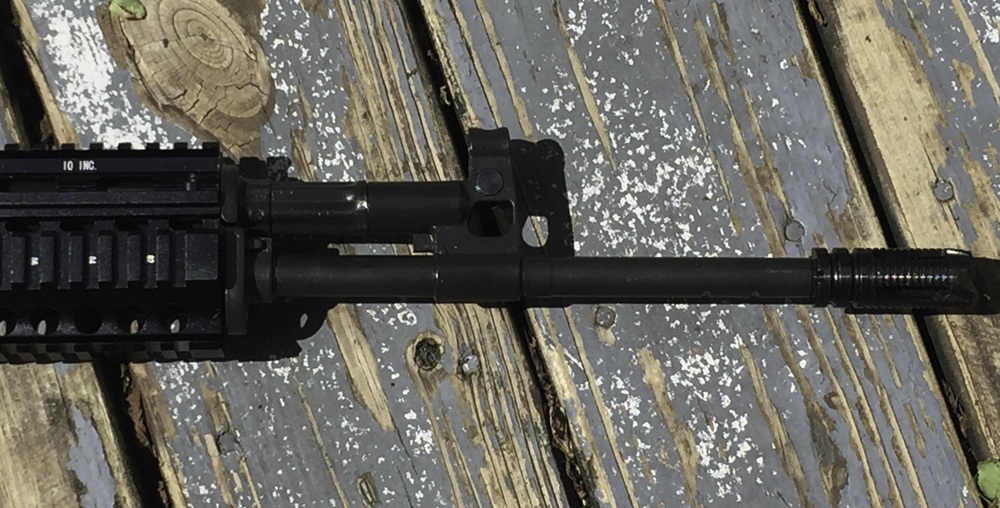
It was done. Stepping back and looking at my creation, I was very satisfied with the way the AK-12 looked. It looked very close to the original. I did try to use most of the accessories in Dark Earth color to match the Russian AK-12, but stopped short of painting the whole gun, instead retaining the option of reconfiguring it later.
Nevertheless, my AK-12 felt light and had an aura of “niftiness” about it. I have shouldered it several times and it felt almost intuitive. The ergonomics were improved and, at the same time, it retained the AK familiarity. Other than that, it looked and felt like a foreign gun and it also looked and felt like an AK. It cycled very well with no hang- ups. All controls worked as they should, and the two-stage FIME Group trigger group felt very crisp. The only question was, would it shoot and would it shoot well?
At the range, I set up at 50 yards, as I was more interested in the gun’s function than accuracy. I would check that later. For the first series of tests I installed the modified AK-74 brake to see if there was a difference between the standard AK-74 and my newly minted clone.
First shots did not disappoint. The clone worked great and, in the best AK-74 tradition, was easy to shoot with no appreciable recoil.
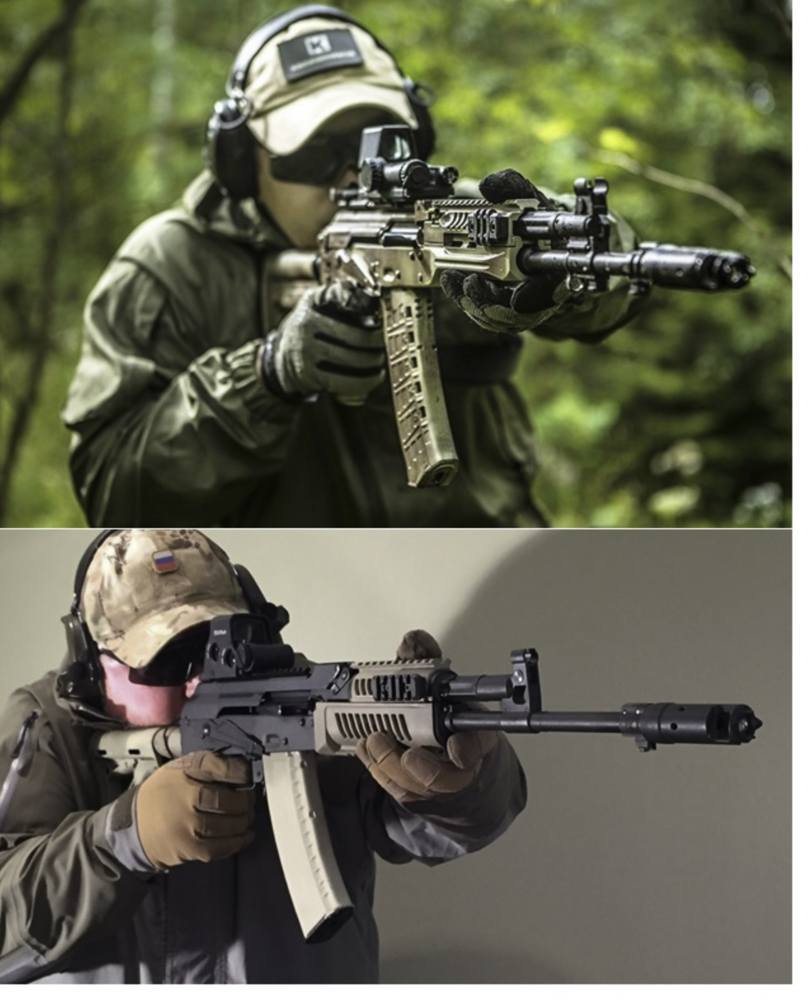
I switched the muzzle devices, installing the modified Tantal brake. With the Polish-design brake, the next series of shots was surprising. The gun was noticeably smoother and its already almost negligible recoil was reduced even further. I was impressed to say the least. So far, the gun was working well. Of course, I could not compare it the original. However, assumptions could be made. And, if the Russians did similar internal upgrades as I’d done, the new AK-12 is better than the AK-74M.
I’m not putting myself in the same group with Russian firearm designers, engineers and gun makers. Even though I’m a mechanical engineer, I don’t know the intricacies of thete firearm design. All I can do is wrap my head around the mechanics of it, add some physics principles, and try to replicate a result, sort of a “proof of a concept,” if you will.
So, as far as I was concerned, it worked. My AK-12 clone looked very similar to the Russian AK-12 Avtomat and shot exceptionally well, enough for me to adopt it as one of my work rifles.
At the range, I continued to test my new gun. I used its open sights to see if it would produce a decent group and it did. All 30 rounds nestled in a tight group at the 1 o’clock spot, approximately 1 inch off the bull’s eye of the target. At 100 yards, my group opened up some, but was still way within my expectations.
In my hands, I had a gun that not only looked and felt great, but also worked well.
After installing a generic red-dot sight, I went to work on steel silhouette targets set up at 50 and 100 yards. It was a pleasure to put it mildly. The AK-12 clone’s meager recoil allowed me to maintain a dot on the target while firing at all times and at both distances.
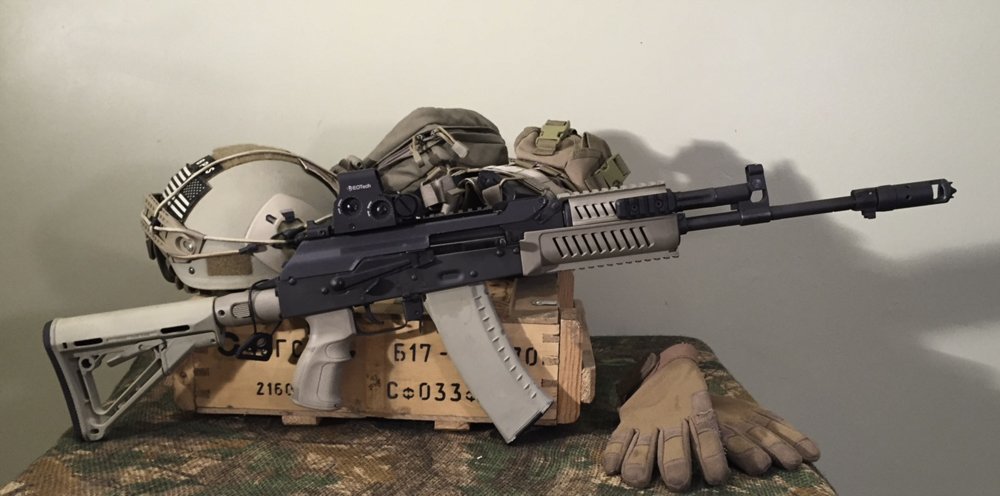
Rapid semi-auto fire was an easy task. The gun felt like something you want to fire on the move during a carbine course or competition. I love the fact that I was able once more to build a gun that closely mimics the appearance and possibly the performance of the newest Russian Avtomat, and I did it with parts available in the U.S. at reasonable prices.
Is the AK-12 the last AK, the last link in its evolution? I don’t know. In fact, no one does. As the “Old Guard” gun makers die off or retire, more and more voices in Russia today call for a completely new firearms system. It is time to replace the ancient technology, they say.
I’m not sure I agree with them. One part of me, the engineering part, agrees. I would always love to see something new and different. But, would I stake my life on it? That’s where my other side takes over, the practical side, the soldier side, the reasonable side.
Why would anybody want to replace a gun platform that has been in service for 80 years? Maybe I let the Russian in me take over with its trademark conservatism. If it’s not broke, don’t fix it, I say.
Editor’s Note: This excerpt is from AK-47: Survival and Evolution of the World’s Most Prolific Gun, available now at GunDigestStore.com.

Next Step: Get your FREE Printable Target Pack
Enhance your shooting precision with our 62 MOA Targets, perfect for rifles and handguns. Crafted in collaboration with Storm Tactical for accuracy and versatility.
Subscribe to the Gun Digest email newsletter and get your downloadable target pack sent straight to your inbox. Stay updated with the latest firearms info in the industry.

![Best Concealed Carry Guns In 2025 [Field Tested] Wilson Combat EDC X9S 1](https://gundigest.com/wp-content/uploads/Wilson-Combat-EDC-X9S-1-324x160.jpg)


![Best 9mm Carbine: Affordable PCCs [Tested] Ruger Carbine Shooting](https://gundigest.com/wp-content/uploads/Ruger-Carbine-Shooting-100x70.jpg)
![Best AR-15: Top Options Available Today [Field Tested] Harrington and Richardson PSA XM177E2 feature](https://gundigest.com/wp-content/uploads/Harrington-and-Richardson-PSA-XM177E2-feature-100x70.jpg)

You lost us at I.O